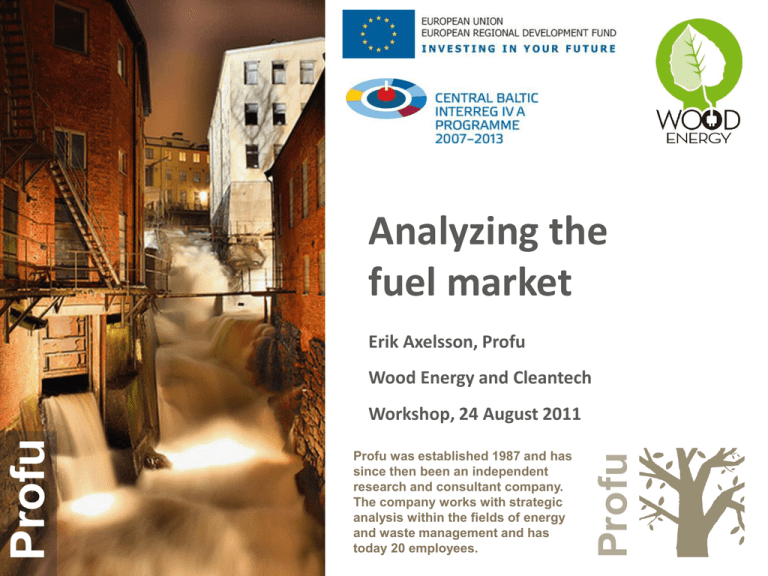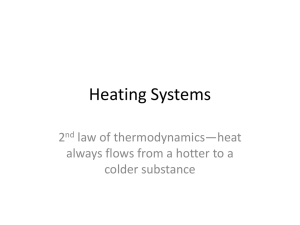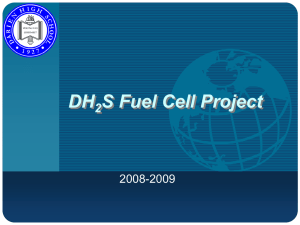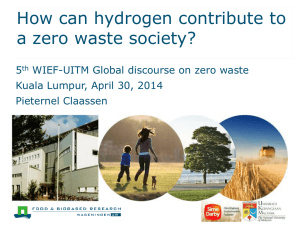Analyzing the Fuel Market
advertisement

Analyzing the fuel market Erik Axelsson, Profu Wood Energy and Cleantech Profu was established 1987 and has since then been an independent research and consultant company. The company works with strategic analysis within the fields of energy and waste management and has today 20 employees. Profu Profu Workshop, 24 August 2011 Profu Research and consulting company Internationally Waste Nationally Locally Energy Profu Environment Outline • The importance of analyzing the fuel market • Drivers for wood fuel prices – experience from the developed Swedish wood fuel market • Development of district heating in European– results from the Pathways project • Bio energy flows in Europe Profu • How to construct consistent energy price scenarios Profu The importance of analyzing the fuel market Profu Energy prices are decisive for profitability Energy prices are not stable Price of “tops and branches” in Sweden 1994-2010 Profu Source: Swedish Energy Agency Profu Energy prices can be local Policy instruments can have a great impact Profu Source: Noordpool and Svenska Kraftnät Profu One needs to understand the (local) energy market to be able to run profitable energy companies Outline • The importance of analyzing the fuel market • Drivers for wood fuel prices – experience from the developed Swedish wood fuel market • Development of district heating in European– results from the Pathways project • Bio energy flows in Europe Profu • How to construct consistent energy price scenarios Wood fuel is a significant part of the Swedish energy system Profu Source: Swedish Energy Agency Fuel for district heating 1981 Bränslemix Bränslemix 2001 Bränslemix 2001 Bränslemix 1981 RT-flis 2% Övrigt 3% RT-flis 2% Övrigt 3% Kol 2% Kol 2% Olja 7% Olja 7% Övrigt 5% Övrigt 5% Spillvärme 3% Spillvärme 3% Avfall 5% 5% Avfall Naturgas 6% Naturgas 6% 3%3% KolKol El 3% 1981 Trädbränsle 28% Trädbränsle 28% El 3% Tallbeckolja 3% Värmepump 14% Värmepump 14% Torv 5% 2001 Hetvatten 9% Tallbeckolja 3% Torv 5% Avfall 11% Hetvatten Biogas 1% 9% 9% Spillvärme Olja 84% Olja 84% Spillvärme 9% Avfall 11% Biogas 1% Värmeleveranser ca 46,5 TWh 27 TWh ThereVärmeleveranser is a established market Värmeleveranser 27 TWh for wood fuel in DH in Sweden, which Profu follows Värmeleveranser Fossilt bränsle 9% El 3% ca 46,5 TWh Biobränslen 49% Värmepumpar 9% Spillvärme 8% 2015 Biogas 2% 2008 Avfall 15% Source: Waste Refinery Profu Torv 5% Supply and demand sets the wood fuel price Price Oil Substitution Supply CHP Transportation fuel Profu Quantity Factors that decrease supply of wood fuel • Decreasing activity in saw mills • Increasing activity in pulp mills Profu • Decreasing use of new wood fuel fractions, such as stumps and residues Factors that increase demand for wood fuel • Increasing demand of district heat • Decreasing use of waste fuel • Increasing price of electricity certificates (e.g. due to poor development of wind power) • Strong development of biofuel production (transportation fuel based on biomass) Profu • High export to other regions/countries Scenario with high wood fuel price: • Saw industry stagnates but pulp industry flowers. • Stumps etc. are not used intensively • Increasing demand of district heat and decreasing use of waste fuel • Increasing price of electricity certificates (e.g. slow development of wind power) • Strong development of biofuel production (transportation fuel based on wood) Profu • High export of wood fuel to other countries Profu By analyzing factors that influence fuel prices (e.g. wood fuel) one can make more qualified projections of the future fuel price. Development of the European district heating: Profu Results from the Pathways project Pathways to Sustainable European energy systems • Five year interdisciplinary project • More than 40 researches • More than 30 topics – e.g. DH • Two main pathways are proposed: Policy Pathway, more demand side oriented Market Pathway, more supply side oriented Profu Se more on: www.energy-pathways.org Profu Potential for DH in Europe Development of DH in Europe Market Profu Policy Development of DH in Europe Bio mass Natural gas Market Profu Policy Profu Increasing use of wood fuel in district heating is expected in Europe, but level of increase depends on the characteristics of the pathway of the European energy system Profu Bio energy flows in Europe Bio energy trade is a cost effective option for meeting CO2 emission targets Hansson and Berndes (2009) Profu Future bioenergy trade in EU – modelling trading options from cost -effective perspective. Bio mass supply in Europe Profu Source: Refuel, 2008. Supply of biomass and total energy use Profu Source: Refuel, 2008 and Eurostat, 2011. Supply of wood fuel compared to total energy use Profu Flow of bio energy Example of expected bio energy flows in Europe Profu Hansson and Berndes (2009) Profu Sweden is not seen as a major net exporter of bio energy, while the Baltic states are. Outline • The importance of analyzing the fuel market • Drivers for wood fuel prices – experience from the developed Swedish wood fuel market • Development of district heating in European– results from the Pathways project • Bio energy flows in Europe Profu • How to construct consistent energy price scenarios Profu Comparison of two investment options Heat: 80 MW NG: 185 MW Bio CHP NGCC Elec.: 28 MW Inv: 100 M€ O&M: 1.2 M€/yr. Elec.: 83 MW Inv: 95 M€ O&M: 0,9 M€/yr. Which option is more robust in a future (2030) energy market? Profu Biomass: 98 MW Heat: 80 MW Energy price scenarios What: Different energy price scenarios that outline possible cornerstones of the future energy market. “Package sensitivity analysis” Use: Analyze robustness of (future) investments with long life time. Important: Consistency within each scenarios. Profu It is not: Energy price prognosis Principle method for constructing consistent price scenarios Fossil fuel prices on the European commodity market Policy instruments Fossil fuel market model Fuel prices and well-to-gate CO2 emissions Electricity market model Electricity price and associated CO2 emissions Bio energy market model Biofuel price and CO2 emission consequences of marginal use of biofuel Price and reduction of CO2 emissions for heat Profu Heat market model Construction of scenarios High and low fossil fuel prices are combined with high and low prices for carbon emissions, to give scenarios with consistent price relations. High Low Price on carbon emissions High Low Sc 2 Sc 1 Price of electricity and wood fuel for sceanrio 1 And so on Profu Fossil fuel prices Principle method for constructing consistent price scenarios Fossil fuel prices on the European commodity market Policy instruments Fossil fuel market model Fuel prices and well-to-gate CO2 emissions Electricity market model Electricity price and associated CO2 emissions Bio energy market model Biofuel price and CO2 emission consequences of marginal use of biofuel Price and reduction of CO2 emissions for heat Profu Heat market model Electricity market model Profu The electricity price is set to the production cost of the build-margin technology with lowest cost of: 1. Conventional coal 2. Coal with CCS 3. NGCC (4. Nuclear) Principle method for constructing consistent price scenarios Fossil fuel prices on the European commodity market Policy instruments Fossil fuel market model Fuel prices and well-to-gate CO2 emissions Electricity market model Electricity price and associated CO2 emissions Bio energy market model Biofuel price and CO2 emission consequences of marginal use of biofuel Price and reduction of CO2 emissions for heat Profu Heat market model Bio energy market model Price of wood fuel i set to willingness to pay for two optional marginal user of wood fuel: 1. Co-combustion in coal power plants. 2. Biofuel producers Price Price Oil Substitution CHP etc Oil Substitution CHP etc Supply Supply DME production Co-firing in coal power plants Quantity Co-firing in coal power plants Quantity Example of energy market scenarios (around 2030) Fuel prices 1 2 3 4 90 90 130 9 90 9 90 14 113 130 14 113 Policy instruments 1 2 3 4 Carbon price (€/tonne) 20 50 20 50 RES-E support (€/MWh) 20 10 20 10 Crude Oil (USD/barrel) Natural gas (USD/Mbtu) Coal (USD/tonne) Profu Scenario Principle method for constructing consistent price scenarios Fossil fuel prices on the European commodity market Policy instruments Fossil fuel market model Fuel prices and well-to-gate CO2 emissions Electricity market model Electricity price and associated CO2 emissions Bio energy market model Biofuel price and CO2 emission consequences of marginal use of biofuel Price and reduction of CO2 emissions for heat Profu Heat market model Example of energy market scenarios (around 2030) Electricity market 3 4 NGCC Coal Coal CCS 54 722 75 345 59 722 80 140 Fuel market 1 2 3 4 Wood fuel price (€/MWh) 24 30 27 32 NG price (€/MWh) - incl. CO2-price 33 40 47 54 Base load build margin El. price (€/MWh) CO2 (kg/MWhel) 1 Coal 2 Profu Scenario Comparison of two investment options Heat: 80 MW NG: 185 MW Bio CHP NGCC Elec.: 28 MW Inv: 100 M€ O&M: 1.2 M€/yr. Elec.: 83 MW Inv: 95 M€ O&M: 0,9 M€/yr. Which option is more robust in a future (2030) energy market? Profu Biomass: 98 MW Heat: 80 MW Profu Comparison of two investment options Profu Comparison of two investment options Profu Comparison of two investment options Profu Remember! Thank you for your attention Profu Götaforsliden 13 nedre, 431 34 Mölndal 031-720 8396/8390, www.profu.se erik.axelsson@profu.se






